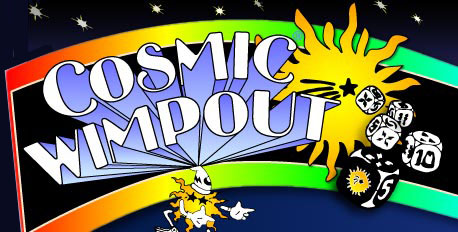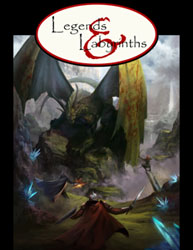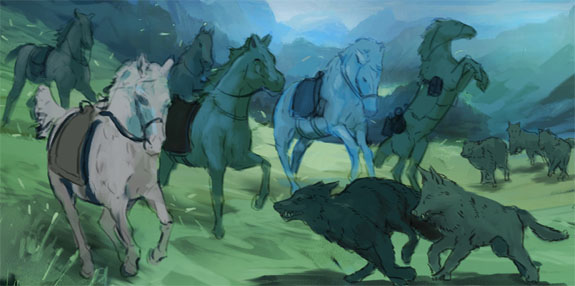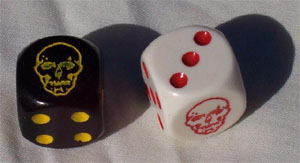This is a fun little dice game I recently re-discovered in one of my desk drawers. I picked it up a couple of years back, so its probably still kicking around. It actually predates the collectible dice games (such as Dragon Dice) which followed in the wake of Magic the Gathering, and instead descends from older traditions.
Cosmic Wimpout comes in a small plastic tube containing five dice, a sheet of instructions, and a “Cosmic Wimpout” sticker. Four of the dice are white and the fifth is black. The four white dice are printed with a 5, a 10, and four symbols. The black die comes repeats the 5 and the four symbols, but replaces the 10 with the “Flaming Sun” symbol.
At the beginning of the game you decide on the game goal (usually 300 or 500 points) and the first player roles the dice.
Three matching faces (on the same throw) are known as a flash, and score various numbers of points depending which symbols or numerals you’ve matched up. Five matching faces (at any time) is known as a Freight Train and, naturally, scores far more points. Unless you roll five 10’s, in which case you’ve scored Too Many Points (a Supernova) and you automatically lose the game. (There’s also a Freight Train combination which automatically wins the game.)
The Flaming Sun is a wild card. The Flaming Sun Rules states that you must use the Flaming Sun to complete a flash if it is at all possible.
A “5” or a “10” by itself scores 5 or 10 points (respectively). A Flaming Sun can also be used to simulate these, unless (of course) the Flaming Sun Rule is in effect.
If you don’t score any points on a role that’s a Wimpout. Your turn is over and you’ve lost all the points accumulated in that turn. Wimping out with all five dice is called a Train Wreck. Unless you Wimpout you can continue rolling any non-scoring dice.
You can stop rolling at any time, scoring the points you’ve accumulated, unless:
1. You haven’t rolled yet.
2. You May Not Want To But You Must — if you’ve scored with all five dice you must roll all five dice again before stopping (risking a Train Wreck).
3. The Futtless Rule states that all flashes have to be cleared – meaning that if you’ve just scored a flash you must score additional points by rolling the non-scoring cubes. The Reroll Clause states that you cannot clear a flash while matching any one of the flash faces when clearing. (So if you roll three fives you’d flash; at which point you’d have to reroll the remaining dice and score additional points… but if one of the dice comes up a five you’d have to roll all the remaining dice again.)
Finally, once a player has reached the game goal everybody else gets one last chance to catch up and surpass their score.
It’s a fun little game. It fits easily in a lapel pocket I’ve found and is easy to teach to your friends quickly. Any number of people can play and it’s appropriate for just about any social gathering.
I don’t know how available this game is any more, so I’m going to include the address found on the instruction sheet:
Cosmic Wimpout
P.O. Box 3199
Greenfield, MA 03012
That’s current as of 1993 – which is, of course, an eternity in this industry. I hope you have luck finding it.
Style: 4
Substance: 4
Company/Publisher: C3, Inc.
Cost: $4.95
Page count: n/a
ISBN: n/a
Originally Posted: 1999/05/28
In the years since this review appeared, Cosmic Wimpout has appeared on the web! You can find it here. Apparently the game has been around since the 1970’s.
For an explanation of where these reviews came from and why you can no longer find them at RPGNet, click here.

















